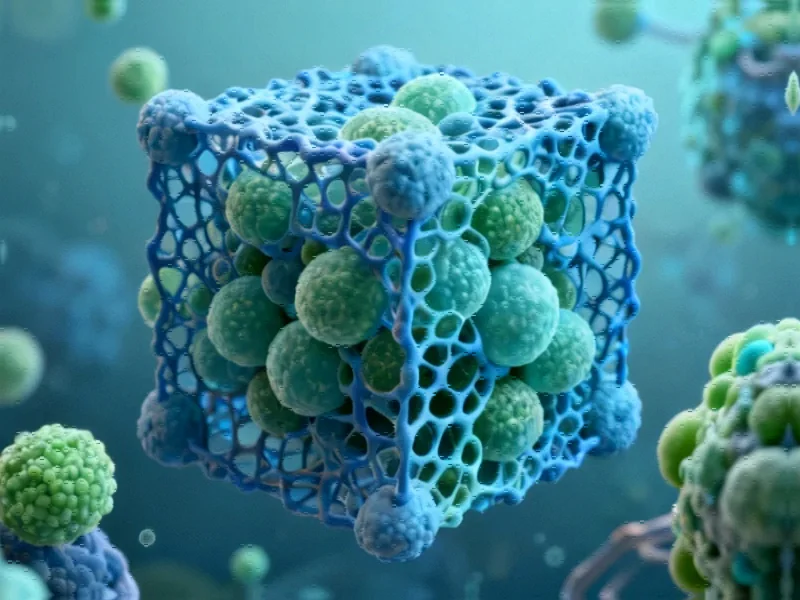The Scaffolding Revolution in Cellular Agriculture
The race to perfect cultured meat production has intensified focus on one critical component: scaffolding technology. While traditional approaches relied on animal-derived materials, recent breakthroughs in non-animal scaffolds are addressing the fundamental challenges of texture, structure, and scalability that have hindered commercial viability. These innovations span multiple scientific disciplines, from peptide engineering to advanced manufacturing techniques, collectively pushing the boundaries of what’s possible in cellular agriculture.
Self-Assembling Peptides: Nature-Inspired Structural Engineering
At the forefront of scaffold innovation are self-assembling peptides, which represent a paradigm shift in how we approach tissue structuring. These remarkable molecules autonomously organize into complex three-dimensional architectures that closely mimic the extracellular matrix (ECM) found in natural tissues. The underlying mechanisms driving this self-organization reveal nature’s sophistication—through either differential adhesion hypothesis or differential interfacial tension, these peptides create optimal environments for cell growth and differentiation.
What makes peptide scaffolds particularly promising is their programmability. Researchers have developed coatings incorporating specific sequences like arginyl-glycyl-aspartic acid (RGD) that not only promote cell adhesion but also include controlled detachment sites. This dual functionality enables continuous production cycles, addressing one of the major bottlenecks in industrial-scale cultured meat manufacturing. However, as with many emerging technologies, significant challenges remain in cost reduction and mechanical stability for long-term bioreactor applications.
Advanced Manufacturing Techniques Scaling Production
The translation from laboratory success to industrial production requires manufacturing technologies capable of meeting commercial demands. Recent industry developments in electrospinning, particularly needle-free and multi-needle systems, have demonstrated remarkable scalability potential. Production rates reaching up to 1 kg/hour or more represent a quantum leap from earlier capabilities, making electrospun materials increasingly viable for commercial applications.
Meanwhile, 3D bioprinting continues to evolve beyond its 1986 origins, offering unprecedented precision in scaffold fabrication. The technology’s versatility spans multiple approaches—including inkjet, laser-assisted bioprinting, extrusion-based bioprinting, and stereolithography—each requiring specialized bioinks optimized for cellular fidelity and viability. The implications for food production extend beyond mere structure; 3D bioprinting enables customization of shape, composition, and nutritional fortification, potentially addressing current limitations in texture-modified foods.
Crosslinking Strategies: Balancing Stability and Safety
The structural integrity of scaffolds depends heavily on crosslinking methods, which have evolved significantly in recent years. Physical crosslinking techniques, including steam sterilization, water annealing, and hydrogen bonding, offer compelling advantages in food safety by avoiding chemical additives. Research demonstrates that physically crosslinked scaffolds can achieve pore sizes ranging from 50 to 250 μm while supporting robust cell adhesion and proliferation—even without additional ECM protein coatings.
Chemical crosslinking, while creating more stable structures, presents toxicity concerns that have driven innovation toward safer alternatives. Traditional crosslinkers like glutaraldehyde, formaldehyde, and various epoxy compounds, despite their effectiveness, pose significant health risks that complicate regulatory approval and consumer acceptance. The emergence of enzymatic crosslinking represents a promising middle ground, providing structural stability while maintaining biocompatibility. These related innovations in crosslinking methodology reflect the industry’s growing sophistication in balancing mechanical requirements with safety considerations.
Material Science Breakthroughs and Bioink Development
The palette of materials available for scaffold construction has expanded dramatically, with biopolymers like gelatin, agarose, cellulose, alginate, pectin, and plant proteins demonstrating remarkable versatility. Each material offers unique crosslinking mechanisms—thermal, pH-based, enzymatic, or radiation-induced—enabling precise control over hydrogel formation and structural properties. The development of specialized bioinks represents a critical intersection of material science and biological requirements, where fluid properties must balance with post-printing stability.
Recent research into glucuronoxylan-based quince seed hydrogels illustrates the nuanced relationship between crosslinking density and scaffold performance. Studies show that increased crosslinking creates denser structures with reduced pore size and porosity—parameters that directly influence cell migration, nutrient diffusion, and ultimately, tissue development. This level of control enables researchers to fine-tune scaffold properties for specific cellular agriculture applications, from delicate muscle fibers to more robust connective tissues.
Industrial Implementation and Future Directions
The transition from research to commercial implementation faces multiple hurdles, including regulatory compliance, consumer acceptance, and economic viability. Current market trends indicate growing investment in scaffold technologies that can meet both biological and manufacturing requirements. The stability of printed structures during further processing and cooking represents a particular challenge that researchers are addressing through material combinations and advanced crosslinking strategies.
As the industry matures, questions about nutritional quality, potential nutrient loss, and nutritional stability at scale remain largely unanswered. However, the precision and reproducibility of advanced scaffolding techniques suggest significant potential for optimizing these factors. The ongoing refinement of scaffold technologies continues to push the boundaries of what’s possible in cultured meat production, bringing us closer to products that can genuinely compete with conventional meat in texture, nutrition, and consumer experience.
These technological advances represent just one aspect of the broader manufacturing evolution. As detailed in this comprehensive analysis of scaffold technology breakthroughs, the convergence of biology, materials science, and advanced manufacturing is creating unprecedented opportunities in cellular agriculture. The progress in this sector reflects larger manufacturing evolution across multiple industries, where traditional methods are being reimagined through technological innovation.
The implications extend beyond food production, touching on broader economic and strategic considerations. As seen in strategic resource management and corporate consolidation patterns, advanced manufacturing technologies are reshaping global supply chains and competitive dynamics. Meanwhile, the financial landscape for emerging technologies continues to evolve, as evidenced by shifting financial sector dynamics and policy-driven economic initiatives that could influence investment in cellular agriculture.
The journey toward commercially viable cultured meat continues to accelerate, driven by scaffold technologies that bridge the gap between cellular biology and consumer expectations. As these innovations mature, they promise to transform not only how we produce meat but potentially how we approach sustainable food systems globally.
This article aggregates information from publicly available sources. All trademarks and copyrights belong to their respective owners.
Note: Featured image is for illustrative purposes only and does not represent any specific product, service, or entity mentioned in this article.
